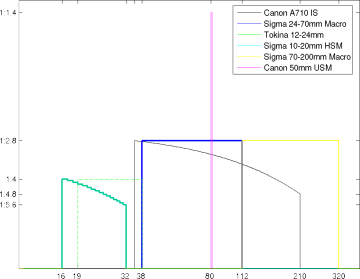Tuesday, August 26. 2008
Canon EOS 50D announced
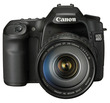
I was really surprised when I read that Canon itself leaked a webpage describing an EOS 50D! The surprise was due to the usual timespan of 1½ years after which Canon presented a successor of their respective EOS line. As the EOS 40D was presented in fall 2007, I didn’t expect a 50D to come before spring 2009. But probably the 50D came a little earlier to be placed against Nikon’s D300 that really outperforms the 40D.
Having a brief look at the specs I have the impression that it’s rather a minor advance compared to the 40D, fortifying the impression of a pure marketing decision rather than a real technology jump. The significant changes in my eyes are
- 15 MP compared to 10 MP,
- DIGIC IV processor compared to DIGIC III, and
- ISO 12800 max. compared to ISO 3200.
In the end only the last one in that list could be of interest if it implies a lower noise behavior at the same ISO speed. The jump from 30D to 40D was much more significant in my eyes, while that from 20D to 30D was only a cosmetic one in a similar way. However, as there obviously won’t be another successor in spring 2009, I can now be sure that my EOS 40D will stay a top camera for at least another year.
Much more interesting in my eyes is the upcoming EOS 5D
Thursday, August 14. 2008
Digitale Bilder organisieren

Obwohl ich schon einmal hier laut darüber nachgedacht habe, wie ich meine (digitalen) Fotos organisieren soll, reagiere ich nun auf eine Blogparade zu diesem Thema, auch um mich selbst etwas mehr zur Fotografie anzuspornen.
- Auf wie vielen Datenträgern speicherst Du Deine Fotos?
Auf drei bis vieren: Eventuell parke ich sie nämlich schon unterwegs auf dem Datentank. Danach habe ich eine Drei-Zeiträume-Strategie: Solange Platz ist, sind die aktuelleren Fotos am Notebook, zur Bearbeitung und zum schnellen Zugriff. Dann werden alle Fotos gemeinsam mit weiteren persönlichen Daten auf einen Backup-PC synchronisiert, der aber wohl bald durch ein USB- oder FireWire-Festplattenarray ersetzt wird; dort sollen sich alle bisher gemachten Fotos befinden. Zuletzt landen die Fotos zur Katastrophenvorbeugung auf DVD-RAMs (nicht CDs und nicht DVD-R(W)s), da diese relativ lange physikalisch haltbar sind; diese werden außer Haus gelagert. Darüber hinaus werden die besten Bilder schlicht ausgearbeitet. - Wie regelmäßig machst du Backups?
Neue Fotos werden sofort aufs Backupmedium synchronisiert. Monatlich kommen sie auf DVD-RAM. Sobald eine DVD-RAM voll ist, verlässt sie das Haus. - In welchem Format speicherst du deine Fotos?
In dem, in dem sie aus der Kamera kommen, d.h. RAW oder JPEG. Bearbeitungen werden immer als separate JPEGs gespeichert; TIFFs habe ich bisher noch nicht benötigt. Nicht überzeugende Fotos werden sowieso gnadenlos gelöscht. - Welche Ordnerstrukturen oder Dateinamen verwendest Du?
Bisher lege ich die Ordner einfach in der Form YYYY/MM/DD_Thema an, die Dateinamen bleiben die aus der Kamera. Ableitungen erhalten ein Suffix. - Wie indizierst Du Deine Fotos?
Mit digiKam. Allerdings fühle ich in letzter Zeit keinen Bedarf dafür. - Welche Software setzt du ein?
Ich bin sehr hart im Nehmen, setze nämlich zu 100% Linux-Software ein. digiKam verwende ich zum Taggen und Aussortieren, GIMP zur klassischen Bildbearbeitung, Bibble Pro zur RAW-Konvertierung, QtpfsGUI zum HDR-Berechnen, und schließlich das Triplett aus Hugin, Autopano-SIFT und Enblend zur Erstellung von Panoramabildern. Desweiteren besitze ich eine Noise Ninja-Lizenz. Unter den Linuxern gehöre ich also zu den Pragmatikern, die nicht ausschließlich freie Software benutzen. Das Backup selbst fahre ich mit rsync.
Thursday, July 31. 2008
Wide angle views

 I finally bought the EF-S 10-22mm lens, although I promised myself to
already buy it together with the tripod. I couldn’t wait any longer, as I noticed
more and more often that the most incredible landscape shots simply
were taken at a (miniature equivalent) 16mm focal length. For the 1.6×
cropped sensor of my EOS 40D I thus need a real focal length of 10mm, what this lens
provides. I had already noticed myself that the lower 17mm (equ. 27mm)
of my standard zoom provide a little too narrow view at e.g. the sky or a room or a yard or a building or
the surroundings of an object. Also, wide angle views turn out to look
more creative, as the object of interest appears huge while you get
closer to it. However, I often hear that beginners are better equipped
with a lens at the upper focal length range; a telephoto lens. It’s
said that this makes it easier for them to compose images and push disturbing objects out of view.
Nevertheless, I simply didn’t feel an urge for higher focal lengths,
quite the opposite.
I finally bought the EF-S 10-22mm lens, although I promised myself to
already buy it together with the tripod. I couldn’t wait any longer, as I noticed
more and more often that the most incredible landscape shots simply
were taken at a (miniature equivalent) 16mm focal length. For the 1.6×
cropped sensor of my EOS 40D I thus need a real focal length of 10mm, what this lens
provides. I had already noticed myself that the lower 17mm (equ. 27mm)
of my standard zoom provide a little too narrow view at e.g. the sky or a room or a yard or a building or
the surroundings of an object. Also, wide angle views turn out to look
more creative, as the object of interest appears huge while you get
closer to it. However, I often hear that beginners are better equipped
with a lens at the upper focal length range; a telephoto lens. It’s
said that this makes it easier for them to compose images and push disturbing objects out of view.
Nevertheless, I simply didn’t feel an urge for higher focal lengths,
quite the opposite.
Well, and although I originally wanted to plan far into the future by only buying lenses that could be used on FF sensors one day, this is already my second lens that just fits on crop sensors. So, what about that? I finally came to an opinion that I found best expressed in the 10-22mm lens review by Bob Atkins:
Some people refuse to buy EF-S or other APS-C coverage lenses because “one day” they intend to own a full frame DSLR and I guess that’s a valid viewpoint. It would be more valid if they actually owned a full frame DLSR now, but I suppose they are planning ahead. Personally I think I’ll be shooting with a 1.6x DSLR for at least the next 3-4 years, and even if I buy a full frame DLSR at that point I’ll probably keep a 1.6x body for backup.
’Nuff said.
The first serious use of that lens will be the documentation of our current and our new lodging that’s currently under construction. But I’ll mainly aim that tool at landscapes.
Monday, June 9. 2008
Getting more professional

Meanwhile two more tools went into my gear: A pricey outdoor photo backpack (Lowepro Primus AW) and a tripod (Manfrotto 190XPROB with 3D head 804RC2). I need the tripod to make nice long exposures, e.g. in low light or for flowing water, and the backpack is able to carry it.
However, for a city guy like me it isn’t that easy to start doing nature photography. This weekend I had planned to capture the sunrise at a pond, hoping for nice morning fog and reasonably clear sky, as it was rather rainy. However, we met friends in the evening before, had some pizza, and I went to bed after midnight. The alarm clock was set for 4.00am. At about 2.30am I woke up with a slight heartburn, and couldn’t fall asleep again until I finally turned the planned alarm off. At about 6.30am I woke up again and had a look outside the window: Morning fog, sunrise glowing in orange and yellow. Damn!
But I think it’s just a case of getting used to that, and probably I have it in my genes anyway, as my father is a passionate huntsman and used to getting home late or up early, enjoying to sit in the dark cold for hours. Next try coming soon.
Wednesday, December 19. 2007
Mine!

It took me long to finally get there, but the EOS 40D is now mine, all mine! I spent more than €2700 today for the body, the EF-S 17-55mm, two 4GB CF cards, a polarizer, a cleaning brush and a bag. I had some vouchers with a total of €500, and Canon’s Cashback sales promotion will decrease the amount by another €130.
The first thing I thought at home after unpacking was: What the hell am I going to do with such a big camera? ![]() I just spent an impressive amount of money on something that I’m yet unable to use! That expensive device is to be handled with care, so: Am I really willing to take it out when it’s freezing outside? Am I really willing to take an uncomfortable, rigid bag with me to crowded places? The answer obviously is: Well, if you spend so much money on such a thing, then, yes, you have to take your camera out to crowded places on freezing days!
I just spent an impressive amount of money on something that I’m yet unable to use! That expensive device is to be handled with care, so: Am I really willing to take it out when it’s freezing outside? Am I really willing to take an uncomfortable, rigid bag with me to crowded places? The answer obviously is: Well, if you spend so much money on such a thing, then, yes, you have to take your camera out to crowded places on freezing days!
But before I do so, I have to become acquainted with the camera. It wouldn’t make sense to try to shoot nice pictures seriously when the result isn’t predictable.
Friday, September 21. 2007
Ultimate lens considerations, IV

I noticed that a 24-70mm lens definitely cannot be a standard walkaround lens for a 1.6× crop camera, as the equivalent 38mm are definitely not wide angle. I’d have to switch to the dedicated wide angle lens too often. Sure, my PowerShot also starts at only 35mm, but most compact cameras simply lack wide angle focal lengths. Therefore I was thinking about a lens that starts at 17mm or 18mm, what equals 27-28mm on a crop camera. There were several candidates, and I was struggling a lot, as each had its advantages and disadvantages. One promising candidate was the Canon EF 17-40mm f/4 L USM, but although it is a Luxury (L) lens and has an ultrasonic motor, it is rather slow and has no Image Stabilizer, what actually makes it a worse choice compared to the 24-105mm f/4 L IS USM that I was considering earlier. Competing lenses from other manufactures are faster and cheaper, but they lack an ultrasonic motor and are calculated for the APS-C circle only. In addition, the upper limit of 40mm would have made a dedicated 50mm lens almost inevitable.
 I finally broke it down to the Canon EF-S 17-55mm f/2.8 IS USM [Review] that I already had in mind earlier. It is definitely the best choice for a crop camera today. It is fast and has an Image Stabilizer, making it a perfect lens for portraits or available light photography. In addition, it has an ultrasonic motor. It could almost be considered as an L-series lens, but it isn’t, as it’s also just calculated for APS-C sensors. All in all it’s rather expensive at €1099, but I’ll definitely make use of it.
I finally broke it down to the Canon EF-S 17-55mm f/2.8 IS USM [Review] that I already had in mind earlier. It is definitely the best choice for a crop camera today. It is fast and has an Image Stabilizer, making it a perfect lens for portraits or available light photography. In addition, it has an ultrasonic motor. It could almost be considered as an L-series lens, but it isn’t, as it’s also just calculated for APS-C sensors. All in all it’s rather expensive at €1099, but I’ll definitely make use of it.
 And while I’m considering a Canon lens as primary lens, I now keep an eye on the Canon EF-S 10-22mm f/3.5-4.5 USM [Review] lens. I just prefer it to the Sigma because it’s a Canon, is a little faster and has a little wider focal length range. It has a bit more of a plastic feeling than the Sigma, but the minor weight is no disadvantage. It’s at €759 at my preferred dealer, and I’ll buy it sometime at the beginning of 2008 together with a tripod.
And while I’m considering a Canon lens as primary lens, I now keep an eye on the Canon EF-S 10-22mm f/3.5-4.5 USM [Review] lens. I just prefer it to the Sigma because it’s a Canon, is a little faster and has a little wider focal length range. It has a bit more of a plastic feeling than the Sigma, but the minor weight is no disadvantage. It’s at €759 at my preferred dealer, and I’ll buy it sometime at the beginning of 2008 together with a tripod.
![]() The tele lens, the tele lens. Sure, the Sigma would be a great choice, but why not taking a fast lens that additionally provides image stabilization? The Canon EF 70-200mm f/2.8 L IS USM [Review] is usable without a tripod and has some reserves for being used together with a teleconverter. Sure, it’s really expensive with €1999, that’s why I won’t buy it too soon, maybe in about one year.
The tele lens, the tele lens. Sure, the Sigma would be a great choice, but why not taking a fast lens that additionally provides image stabilization? The Canon EF 70-200mm f/2.8 L IS USM [Review] is usable without a tripod and has some reserves for being used together with a teleconverter. Sure, it’s really expensive with €1999, that’s why I won’t buy it too soon, maybe in about one year.
 I still want to have a dedicated fast portrait lens like the 50mm f/1.4 by Canon. But I also consider the great Canon EF 50mm f/1.2 L USM [Review]. It is very fast, provides a very narrow depth of field, and is rather expensive at €1369, but it’s really that good. We’ll see what my preferences will be. A flash might be more important for the first time.
I still want to have a dedicated fast portrait lens like the 50mm f/1.4 by Canon. But I also consider the great Canon EF 50mm f/1.2 L USM [Review]. It is very fast, provides a very narrow depth of field, and is rather expensive at €1369, but it’s really that good. We’ll see what my preferences will be. A flash might be more important for the first time.
The main reason for considering the f-stop of 1.2 or the IS for the other lenses is that my PowerShot also has an IS, what actually decreases the aperture values as if the lenses were faster. The following plot of focal length and aperture coverage of the desired lenses considers this by indicated dashed lines:
Thursday, September 6. 2007
Ultimate lens considerations, III

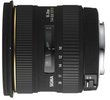 I found yet another wide angle lens that could be of interest: The Sigma 10-20mm f/4-5.6 EX DC HSM [Review]. Although it delivered no overwhelming values in both DigitalPHOTO 05/2007 and ColorFoto 08/2007 due to its vignetting problems in the mid range (though it got a recommendation for the D200 in the same issue), it beat the Tokina 12-24mm f/4 in both the 04/2007 issue of the UK Photography Monthly magazine and the 05/2007 issue of the UK Digital Photo magazine. I found a private tester comparing both lenses to each other and to the Canon EF-S 10-22mm f/3.5-4.5 USM. The main reason why this lens becomes interesting to me is that is reaches a wider angle of 10mm (@16mm) instead of just 12mm (@19mm), what is significant in the wide angle range and provides a noticable wider FOV. Another advantage is that it has an ultrasonic autofocus. A disadvantage is the drop in aperture, but for landscape photography lower f-stops of at least f/8 or f/11 are usual anyway. This already reduces the vignetting, and the effects of vignetting, CA and even optical distortion can be corrected by software anyway; actually, good shots want to be optimized digitally. The lens is at €499 at my dealer.
I found yet another wide angle lens that could be of interest: The Sigma 10-20mm f/4-5.6 EX DC HSM [Review]. Although it delivered no overwhelming values in both DigitalPHOTO 05/2007 and ColorFoto 08/2007 due to its vignetting problems in the mid range (though it got a recommendation for the D200 in the same issue), it beat the Tokina 12-24mm f/4 in both the 04/2007 issue of the UK Photography Monthly magazine and the 05/2007 issue of the UK Digital Photo magazine. I found a private tester comparing both lenses to each other and to the Canon EF-S 10-22mm f/3.5-4.5 USM. The main reason why this lens becomes interesting to me is that is reaches a wider angle of 10mm (@16mm) instead of just 12mm (@19mm), what is significant in the wide angle range and provides a noticable wider FOV. Another advantage is that it has an ultrasonic autofocus. A disadvantage is the drop in aperture, but for landscape photography lower f-stops of at least f/8 or f/11 are usual anyway. This already reduces the vignetting, and the effects of vignetting, CA and even optical distortion can be corrected by software anyway; actually, good shots want to be optimized digitally. The lens is at €499 at my dealer.
Btw, that private tester also compares the 24-70mm f/2.8 lenses of Canon and Sigma to each other.
I drew the following picture of focal length and aperture coverage of my desired lenses:
I chose a logarithmic scaling for the horizontal axis, as slight changes in the lower focal lengths already produce a large change in FOV, whereas focal lengths in the high range have to be doubled or even tripled to yield a higher view detail in the same amount. There’s now a gap in the range between 20 and 24mm (@32-38mm), but I don’t consider that as problem. But the big advantage is the wider FOV, what I assume to use more often than its wide end of 20mm (@32mm). Notice the difference:
| Sigma at 10mm | Tokina at 12mm |
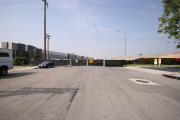 | 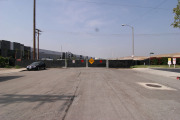 |
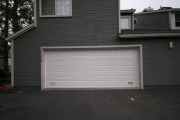 | 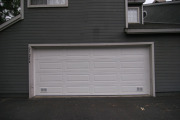 |
About
Calendar
| Mon | Tue | Wed | Thu | Fri | Sat | Sun |
|---|---|---|---|---|---|---|
| ← Back | January '26 | |||||
| 1 | 2 | 3 | 4 | |||
| 5 | 6 | 7 | 8 | 9 | 10 | 11 |
| 12 | 13 | 14 | 15 | 16 | 17 | 18 |
| 19 | 20 | 21 | 22 | 23 | 24 | 25 |
| 26 | 27 | 28 | 29 | 30 | 31 | |

